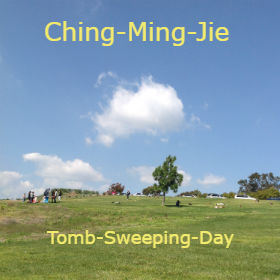
Ching-ming (noun) 清明(Chinese): Tomb Sweeping Day (5th solar term), literally in Chinese “Ching” 清 = pure, “ming” 明 = bright.
Example:
In the ancient Chinese calendar also known as “agriculture calendar”, Ching-ming is a traditional Chinese festival on the first day of the fifth solar term of the traditional Chinese lunisolar calendar. Ching-ming is the 15th day after the Spring Equinox. Ching-ming is also one of the 24 solar terms (Jie-chi 节气). Ching-ming begins at either 4th or 5th of April in the Gregorian calendar year. During Qing-Ming, people go to cemeteries to visit their ancestors’ tombs to show their respects.
Ching-ming has three periods, during the first period 桐始华; the white flowers of tung tree start to blossom, at the second period 田鼠化为鹌; “voles turn into quails” it means that voles all return to their underground holes, and at third period 虹始见 rainbows will be seen for the first time.
Natural flowers, trees, birds and animals all live and move according to a certain season. Their activities are closely related to climate change. Each period 候 in a Jie-qi 节气 is associated with a “flower letter breeze” 花信风. During Ching-ming, the first period is associated with Vernicia flowers 桐花, second period with wheat blossoms 麦花, and third period with willow flower 柳花. In addition to these three flowers, there are Begonia, Magnolia, and peach blossoms that still bloom during Ching-Ming festival.
Ching-Ming is also a time when Chinese people go out enjoying “Spring tour” 春游 (chun-you) literally “chun” 春 = spring, “you” 游 = tour. Another word for “Spring tour” is 踏青 (ta-qing) literally “ta” 踏 = stepping, “qing” 青 = green, and enjoy Spring Outing.
Since ancient times, Ching-ming has been a solar term for agricultural purposes in the lunar calendar. Ching-ming is still remembered and celebrated as a Chinese traditional festival.
